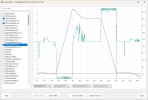I am of the opinion that the
IR sensor will, normally, reduce the speed of a fast descent once the ground is detected. I am sure I have seen this in my drones, most likely the mavic
2s and
mini 1&2. ..... and that's with the throttle fully closed all the way down to landing.
But at what point during descent from greater heights?
I've never taken notice of numerical value but a qualitative recollection is "quite high", in fact I seem to vaguely remember being surprised how high it looked ......,....,but it was a fair while ago.
I tested it in N-mode (Normal) on my Mini.
The manual for the Mini says VPS range is 0.5-30m, but "works best" between 0.5-10m. So I flew the Mini straight up to 40m to ensure it was well out of VPS range. Then I held the throttle full down for maximum descent speed right until the drone auto-landed.
Then, using the Litchi app, I turned off the VPS and repeated the same test, climbed to 40m, then max descent. But, I manually stopped the descent at the last moment to prevent the drone from auguring into the ground.
Lots of interesting things happened, which aren't all the evident from the video alone. I used
@msinger's excellent
Flight Reader to plot some data and graphs to better illustrate what's going on.
First, with VPS enabled, on the way up the IMU height (barometric) and the VPS height (infrared) agreed only until 12.2m. After that VPS lost contact and froze at 12.2m, while the barometric altimeter continued recording the increasing height.

On the way down the VPS first detected ground only from a height of 6.5m (21ft) and down.

Here's the data plotted, with the
BLUE line showing the barometric altimeter climbing up to 40m height, while the
RED VPS height stops recording (flat-lined) at 12.2m.

The
GREEN line is the vertical speed with ascent speed shown as negative, and descent as positive [
which seems backwards to me]. Max ascent speed was 2.0m/s and max descent fluctuated between 1.7-1.8m/s.
With the throttle stick held full down, the
GREEN line is holding at its steady maximum descent speed 1.7-1.8m/, until at 78.4s the VPS comes alive again. It drops from its frozen 12.2m to suddenly show showing a height of 6.5m and falling. Here the line of the
RED VPS height again closely overlays and matches the
BLUE barometric height.
But interesting stuff starts to happen at 80secs beginning at a height of 2.8m (9ft). Still with the throttle stick held full down, the VPS senses the rapidly approaching ground and starts applying the brakes. The vertical speed bleeds off to zero and very briefly hovers at 0.5m height, before announcing Landing.
The last little blip in the
GREEN vertical speed line shows the descent speed briefly increasing from zero (hover) until settling to an auto-landing. Cool.
The weird thing is the divergence between the
RED VPS height and
BLUE barometric height in the final phase. They are closely aligned, while VPS is active, until the moment at 80sec when the drone automatically started applying the brakes at 2.8m(9ft) to begin slowing its descent. At landing the VPS accurately shows ZERO height, whereas the barometric altimeter shows -1.4m.
Below is the same test with VPS switched OFF. Note the
RED VPS height is shown as a continuous flat line at zero height.
The
BLUE line displays the barometric height. I was aiming to climb to 40m, but overshot to 45m.
The
GREEN line [
again counter-intuitively] displays ascent speed as negative and descent speed as positive. So the squiggly
GREEN line at top right is displaying constant max descent speed, again fluctuating between 1.7-1.8m/s, with a corresponding decline in height shown by the BLUE line until 110secs when I chickened out and released the throttle stick at a height of 1.6m (5ft).
Obviously without VPS providing auto-braking, had I continued to hold the throttle down the drone would have smacked straight into the ground.

Note the
BLUE line, barometric altimeter, after I stopped its descent and then manually lowered the drone to landing. It briefly recorded a "height" of 2.4m below ground! I think that's due to the ground effect buildup of propwash pressure trapped between the drone and ground. The barometer interprets increased pressure as lower altitude.
There's one other thing to watch out. In any auto-landing with VPS enabled as normal, at the last moment before touchdown the gimbal automatically pitches the camera back up to horizontal. That doesn't happen when VPS is disabled!
I had the camera aimed straight down, and it stayed like that. With the camera pitched straight down, there's very little clearance between the ground and camera's lens. If you ever try disabling the VPS on your drone, make sure to rotate the camera back up from vertical before landing because any pebble on the ground might scratch your lens.
Here's the video. @
Yorkshire_Pud, I added CC captions for ya.
















